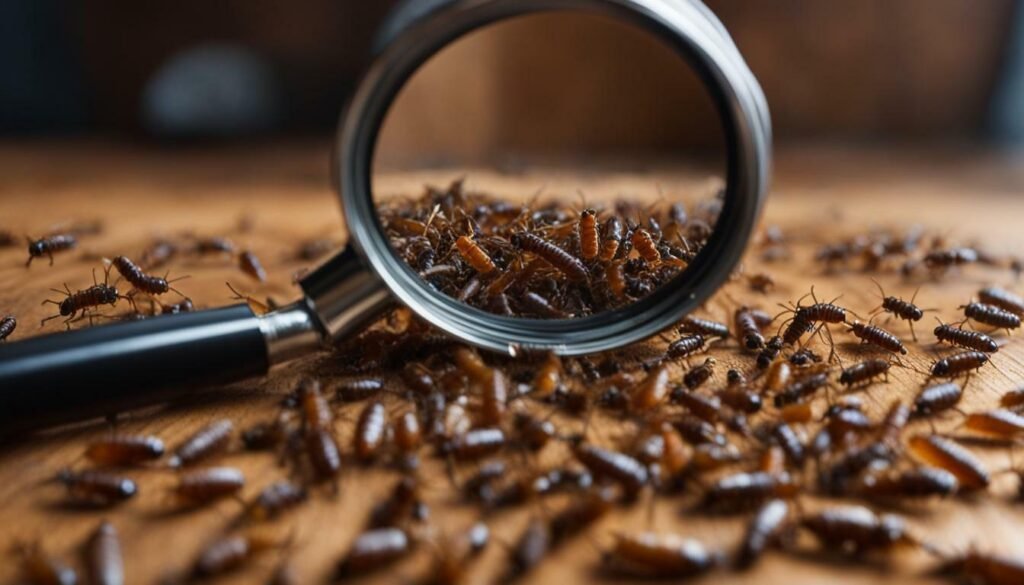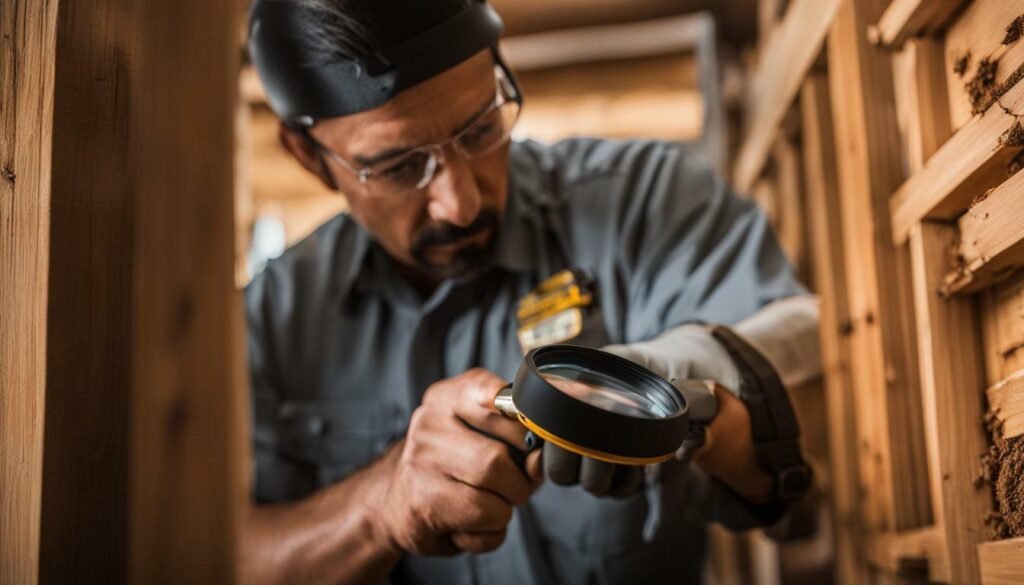Wondering how often you should schedule termite treatments? Having a termite control plan in place is crucial for maintaining a pest-free property. Termites can cause extensive damage if left untreated, so understanding the frequency of termite treatments and prevention methods is essential to protect your home.
Key Takeaways:
- Regular termite inspections are vital for early detection and prevention of infestations.
- Signs of a termite infestation include mud tubes, wood damage, discarded wings, termite droppings, and sagging floors.
- Liquid termite treatments should be re-treated every five years to ensure long-lasting effectiveness.
- Termite bait stations should be inspected regularly to monitor termite activity and maintain control.
- Additional preventive measures include sealing cracks, reducing moisture, removing wood-to-soil contact, and using treated wood or steel in vulnerable areas.
By following a termite control schedule and implementing preventive measures, you can safeguard your home against costly termite damage. Remember, professional termite inspections and treatments are recommended for effective control. Stay proactive and maintain a termite-free home!
Understanding Termite Infestations and Prevention
Before we dive into how often you should treat for termites, let’s first understand the signs of a termite infestation and the optimal timing for prevention. Termite infestations can cause significant damage to your property if left untreated. Therefore, it’s important to be aware of the common signs that indicate the presence of termites.
Some of the key signs of a termite infestation include mud tubes, wood damage, discarded wings, termite droppings, and sagging floors. If you notice any of these signs in your home, it’s crucial to take immediate action to prevent further damage.
When it comes to termite prevention, timing is of utmost importance. It’s essential to implement preventive measures before termites have a chance to invade your property. The optimal timing for termite treatment is typically during the spring season when termites are most active. By taking proactive steps to prevent their entry during this time, you can significantly reduce the risk of infestation.
Termite prevention involves a multi-faceted approach that may include liquid termite treatments, termite bait stations, and other preventive methods. Liquid termite treatments should be re-treated every five years to ensure ongoing protection against these destructive pests. Additionally, regular inspections of termite bait stations are essential to ensure their effectiveness in trapping and eliminating termites.
Table: Signs of a Termite Infestation
| Signs | Description |
|---|---|
| Mud tubes | Elevated tunnels made of mud that termites use for safe passage between their colony and food sources. |
| Wood damage | Presence of hollowed or damaged wood, often with visible tunnels or galleries. |
| Discarded wings | Shed wings near entry points, indicating the presence of reproductive termites. |
| Termite droppings | Pellet-like droppings known as “frass” that termites leave behind as they tunnel through wood. |
| Sagging floors | Uneven or sagging floors that may indicate extensive termite damage in the underlying structures. |
By staying vigilant and taking prompt action, you can protect your property from termite damage. Remember, early detection and regular termite inspections are key to preventing infestations and maintaining a termite-free home.
The Role of Regular Termite Inspections
Regular termite inspections are a crucial part of maintaining a termite-free home. Let’s explore how often you should schedule these inspections and why they are necessary.
Termites are silent destroyers that can wreak havoc on your property if left unchecked. They can cause significant damage to the structural integrity of your home, leading to costly repairs. That’s why it’s important to have regular termite inspections to catch any infestations early on.
So, how often should you schedule these inspections? It is recommended to have a professional termite inspection at least once a year. However, if you live in an area prone to termite activity, such as warm, humid regions, it’s best to have inspections more frequently, every six months or even quarterly.
During a termite inspection, experts will thoroughly examine your property for any signs of termites. They will check for mud tubes, wood damage, discarded wings, termite droppings, and even sagging floors. Early detection of these signs can help prevent extensive damage and save you from costly repairs.
Regular inspections also allow pest control professionals to identify potential termite entry points and recommend necessary preventive measures. By addressing these vulnerabilities, such as sealing cracks, reducing moisture levels, and removing wood-to-soil contact, you can significantly reduce the risk of termite infestations.
Overall, regular termite inspections are an essential part of maintaining a termite-free home. By scheduling inspections at the recommended frequency and implementing preventive measures, you can protect your property and ensure peace of mind.


Table: Recommended Frequency for Termite Inspections
| Location | Recommended Inspection Frequency |
|---|---|
| Warm and humid regions | Every 6 months |
| Moderate termite activity regions | Once a year |
| Low termite activity regions | Every 2-3 years |
Keep in mind that this table serves as a general guideline. Factors such as local climate, history of termite activity, and the age of your property may influence the frequency of inspections. Consulting with a professional pest control expert can help determine the most appropriate inspection schedule for your specific situation.
Liquid Termite Treatments and Re-Treatment Frequency
Liquid termite treatments are a popular choice for termite control. Discover how often these treatments should be re-applied to ensure the best results.
When it comes to termite control, liquid treatments have proven to be highly effective in eliminating these destructive pests. However, it’s important to understand that these treatments require periodic re-application to maintain their potency and effectiveness. Regular re-treatment is crucial to ensure that your property remains termite-free and protected.
The frequency of re-treatment for liquid termite treatments depends on various factors, such as the type of treatment used, the severity of the termite infestation, and the location of your property. In general, it is recommended to re-apply liquid termite treatments every five years for optimal control and prevention.
By following a regular termite maintenance schedule and re-treating your property as needed, you can effectively safeguard your home or business from termites. Remember to consult with a professional pest control provider to assess your specific needs and determine the most appropriate re-treatment frequency for long-lasting termite control.


As a responsible property owner, it is essential to prioritize effective termite control to protect your investment. Regular inspections, preventive measures, and timely re-treatment of liquid termite treatments are key components of a comprehensive termite management plan. By taking proactive steps and working with professionals, you can ensure the longevity and integrity of your property while providing a termite-free environment for you and your loved ones.
Termite Bait Stations and Regular Inspections
Termite bait stations offer a different approach to termite control. Find out how often these stations should be inspected to keep termites at bay. Regular inspections are crucial to ensure the effectiveness of termite bait stations, as they allow for early detection of termite activity and timely intervention.
When it comes to termite bait stations, it is recommended to schedule inspections every three months. These inspections involve checking the bait stations for any signs of termite activity such as mud tubes, termite droppings, or damage to the bait. By inspecting the stations regularly, you can identify potential issues early on and take appropriate measures to resolve them.
During the inspection, the bait stations will be carefully examined to determine if they need to be replenished with fresh bait. This ensures that the bait remains attractive to termites and continues to effectively control their population. Additionally, any damaged or compromised bait stations can be replaced during the inspection to maintain the integrity of the system.
| Termite Control Schedule | Termite Prevention Timeline |
|---|---|
| Inspect termite bait stations every three months | Regularly seal cracks to prevent termite entry |
| Replace damaged bait stations during inspections | Reduce moisture in and around the property |
| Replenish bait as needed | Remove wood-to-soil contact |
Regular inspections are crucial to ensure the effectiveness of termite bait stations, as they allow for early detection of termite activity and timely intervention.
By following a regular termite control schedule and conducting inspections as recommended, you can effectively protect your property from termite infestations. Remember, prevention is key when it comes to termites, and proactive measures can save you from the costly damage that these pests can cause.


Additional Prevention Methods for Termite Control
Aside from regular treatments, there are other preventive methods you can implement to minimize the risk of termite infestations. Let’s delve into these strategies.
Sealing Cracks: One effective way to prevent termites from entering your home is by sealing any cracks or gaps in your foundation, walls, windows, and doors. Termites can squeeze through even the tiniest openings, so it’s important to ensure your home is properly sealed. Use caulk or weatherstripping to seal cracks, and repair any damaged areas promptly.
Reducing Moisture: Termites thrive in moist environments, so reducing moisture levels in and around your home is crucial. Fix any leaks or plumbing issues, ensure proper drainage away from your home’s foundation, and remove standing water from your yard. By keeping your home dry, you can make it less appealing to termites.
Removing Wood-to-Soil Contact: Termites are attracted to wood and soil, so it’s important to eliminate any direct contact between the two. Trim tree branches and shrubs away from your home, and ensure that firewood, mulch, and other wood materials are stored at least 20 feet away. This prevents termites from easily accessing your home.
Table 1: Termite Prevention Checklist
| Prevention Method | Actions |
|---|---|
| Sealing Cracks | Use caulk or weatherstripping to seal cracks in foundation, walls, windows, and doors. |
| Reducing Moisture | Fix leaks and plumbing issues, ensure proper drainage, remove standing water. |
| Removing Wood-to-Soil Contact | Trim tree branches away from home, store firewood and mulch at least 20 feet away. |
By implementing these additional prevention methods, you can significantly reduce the risk of termite infestations in your home. Regular inspections, along with proactive measures, will help ensure your property remains termite-free.


Remember, prevention is the key to protecting your home from termites. By following these strategies and seeking professional termite inspections and treatments, you can safeguard your property and enjoy peace of mind.
Using Treated Wood and Steel in Susceptible Areas
When it comes to termite prevention, using treated wood or steel in susceptible areas can be a game-changer. These materials offer enhanced protection against termite infestations, helping to safeguard your property and minimize the risk of damage. Treated wood is specially treated with chemicals that are toxic to termites, acting as a deterrent and preventing these pests from accessing the wood. Steel, on the other hand, is naturally resistant to termites due to its composition, making it an ideal alternative for areas where termites are prevalent.
Treated wood and steel can be particularly effective in vulnerable areas of your property, such as the foundation, decking, and structural supports. By using these materials, you create a barrier that termites find difficult to penetrate, reducing the likelihood of an infestation and potential damage.
When opting for treated wood or steel, it’s essential to ensure proper installation and maintenance. Regularly inspect the materials for any signs of damage or decay and address any issues promptly. Additionally, be sure to follow the manufacturer’s instructions for treatment and installation to maximize their effectiveness in termite control.
| Benefits of Using Treated Wood and Steel |
|---|
| Enhanced termite resistance |
| Reduced risk of structural damage |
| Long-lasting protection |
| Minimal maintenance requirements |
By incorporating treated wood or steel in vulnerable areas of your property, you can fortify your defenses against termite infestations. However, it’s important to note that these materials do not guarantee complete immunity from termites. Regular inspections, preventive measures, and professional termite treatments are still essential components of an effective termite control plan. By taking a proactive approach to termite prevention, you can protect your home and have peace of mind knowing that you’re actively minimizing the risk of termite damage.


The Importance of Professional Termite Inspections and Treatments
While DIY methods can be tempting, professional termite inspections and treatments are crucial for effective termite control. Discover why it’s important to rely on experts.
Termites are silent invaders that can cause extensive damage to your property without you even realizing it. By the time you notice visible signs of an infestation, the damage is often already done. This is where professional termite inspections come in.
A professional termite inspection involves a thorough assessment of your property, including both the interior and exterior. They have the knowledge and expertise to identify the signs of a termite infestation, such as mud tubes, wood damage, discarded wings, termite droppings, and even sagging floors. By catching the problem early on, you can prevent costly repairs and potential structural damage.
When it comes to termite treatments, professionals have access to specialized products and techniques that are not available to the general public. They understand the behavior and habits of termites, allowing them to develop an effective treatment plan tailored to your specific situation. Professional treatments not only eliminate existing infestations but also provide long-term protection against future termite activity.


Additionally, professional termite treatments often come with warranties, giving you peace of mind knowing that you are protected in case of any future termite issues. This warranty may include regular inspections and retreatments if necessary, ensuring ongoing termite control.
In summary, professional termite inspections and treatments are essential for effective termite control. They provide early detection of infestations, access to specialized products and techniques, and warranties for long-term protection. Don’t risk the structural integrity of your home by relying on DIY methods alone. Call in the experts and safeguard your property against the destructive power of termites.
Maintaining a Termite-Free Home
To ensure your property remains termite-free, following a termite maintenance schedule is key. Let’s explore the best practices and optimal timing for termite treatments.
Regular inspections are an essential part of termite prevention, as they allow you to identify any signs of termite infestation early on. Signs to watch out for include mud tubes, wood damage, discarded wings, termite droppings, and sagging floors. If you notice any of these indicators, it’s crucial to take immediate action and contact a professional termite control specialist.
When it comes to treatments, liquid termite treatments should be re-treated every five years for maximum effectiveness. These treatments create a barrier around your property, preventing termites from entering and causing damage. It is important to follow a regular re-treatment schedule to ensure ongoing protection against termites.
In addition to liquid treatments, termite bait stations are another effective method of termite control. These stations are strategically placed around your property and lure termites to consume bait, which is then taken back to the colony, ultimately eradicating it. Regular inspections of these bait stations are necessary to ensure their continued functionality and effectiveness.


Aside from professional treatments, there are several other preventive measures you can take to minimize the risk of termite infestation. Start by sealing any cracks or gaps in your home’s foundation, walls, and windows. This will help prevent termites from entering your property.
Reducing moisture levels in and around your home is also crucial, as termites are attracted to damp environments. Make sure to fix any leaks promptly, ensure proper drainage around your property, and maintain good ventilation in areas prone to humidity.
Another important step in termite prevention is removing any wood-to-soil contact. Keep firewood, lumber, and other wooden materials elevated and away from the soil. This eliminates potential entry points for termites and reduces the risk of infestation.
Summary:
Regular termite inspections and treatments are essential for maintaining a termite-free home. Signs of termite infestation include mud tubes, wood damage, discarded wings, termite droppings, and sagging floors. Liquid termite treatments should be re-treated every five years, while termite bait stations require regular inspections. In addition to professional treatments, sealing cracks, reducing moisture, removing wood-to-soil contact, and using treated wood or steel in susceptible areas are effective preventive measures. By following a termite maintenance schedule and taking proactive measures, you can protect your home from termite infestations.
Being proactive in termite prevention is key to safeguarding your property from the devastating effects of termite damage. By following a termite maintenance schedule and taking the necessary precautions, you can ensure that your home remains termite-free for years to come.
| Key Points | Actions |
|---|---|
| Schedule regular termite inspections | Contact a professional termite control specialist |
| Retreat liquid termite treatments every five years | Maintain ongoing protection against termites |
| Inspect termite bait stations regularly | Ensure their continued functionality and effectiveness |
| Seal cracks and gaps in your home | Prevent termites from entering your property |
| Reduce moisture levels | Fix leaks, ensure proper drainage, and maintain good ventilation |
| Remove wood-to-soil contact | Eliminate potential entry points for termites |
| Hire professionals for termite inspections and treatments | Ensure effective termite control |
Conclusion
Regular termite inspections, timely treatments, and preventive measures are essential for keeping your property free from termites. By following these guidelines, you can safeguard your home from potential damage.
Termites can cause significant harm to your property if left unchecked. Conducting regular inspections allows for early detection of termite infestations, enabling prompt treatment and preventing costly damage. Look out for signs such as mud tubes, wood damage, discarded wings, termite droppings, and sagging floors, as these are indications of termite activity.
When it comes to treatment methods, liquid termite treatments should be reapplied every five years to ensure continued effectiveness. Additionally, termite bait stations should be inspected regularly to monitor termite activity and address any issues promptly. Implementing these measures will help control termite populations and minimize the risk of infestation.
In addition to inspections and treatments, there are preventative measures you can take to reduce the chances of termites invading your home. Sealing cracks, reducing moisture, and removing wood-to-soil contact are effective ways to make your property less attractive to termites. Consider using treated wood or steel in areas that are susceptible to termite infestations for added protection.
While DIY efforts may prove helpful, it is recommended to seek professional termite inspections and treatments. Pest control professionals have the expertise and specialized equipment to thoroughly assess your property and develop a tailored termite control plan. Their knowledge and experience ensure effective treatment and long-term termite prevention.
In conclusion, maintaining a termite-free home requires a proactive approach. By conducting regular inspections, scheduling timely treatments, and implementing preventive measures, you can protect your property from the devastating effects of termites. Don’t underestimate the potential damage termites can cause; take action to safeguard your home and enjoy peace of mind.
FAQ
Q: How often should I treat for termites?
A: Liquid termite treatments should be re-treated every five years, while termite bait stations should be inspected regularly.
Q: What are the signs of a termite infestation?
A: Signs of a termite infestation include mud tubes, wood damage, discarded wings, termite droppings, and sagging floors.
Q: How often should I conduct termite inspections?
A: Regular termite inspections are crucial for early detection, and it is recommended to have them conducted on a regular basis for effective termite control.
Q: How often should liquid termite treatments be re-treated?
A: Liquid termite treatments should be re-treated every five years to maintain their effectiveness in termite control.
Q: How often should I inspect termite bait stations?
A: Termite bait stations should be inspected regularly to ensure their effectiveness in termite control.
Q: What additional prevention methods can I use for termite control?
A: Additional prevention methods include sealing cracks, reducing moisture, removing wood-to-soil contact, and using treated wood or steel in susceptible areas.
Q: Should I hire professionals for termite inspections and treatments?
A: Yes, hiring professionals for termite inspections and treatments is recommended for effective termite control.
Q: How can I maintain a termite-free home?
A: Regular termite inspections, taking preventive measures, and timely treatments can help maintain a termite-free home.
Source Links
- https://www.getmypests.com/blog/post/the-ultimate-guide-to-termite-prevention-safeguarding-your-sugar-land-home
- https://mast-producing-trees.org/how-to-protect-your-home-or-property-from-termites-a-guide-to-termite-inspection-frequency-and-prevention/
- https://njaes.rutgers.edu/fs338/
Your Expert in Animal Control and Extermination. Trust our experience for humane, effective pest management, protecting your property and ensuring peace of mind with Michael S.





